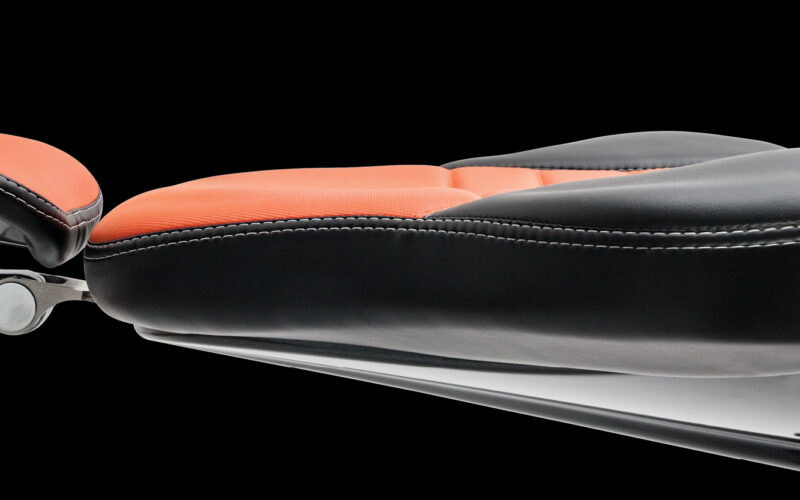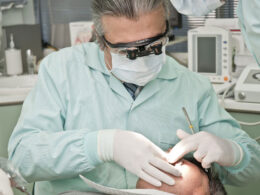Dental chairs, also called patient chairs, play a crucial role in providing comfort and efficiency for patients and dentists alike. If you’re curious about the history of dental patient chairs or information on researching, purchasing, pricing and maintenance, take a look at our previously published guide to buying a dental chair.
In this article, we’ll discuss:
- the importance of this specialized equipment in a busy dental practice,
- the top five signs it’s time to replace your dental chair,
- the stressors that cause wear and tear on a chair’s upholstery and mechanics,
- the times when servicing or repairing a dental chair is preferable.
Importance of dental chairs for patients and dentists
For patients, a dental chair provides a place of comfort, with soft lines and supports that allow them to relax as much as possible during stressful and sometimes painful procedures. Studies show that 50-80% of adults experience at least some anxiety related to dental visits, with around 20% reporting moderate to high anxiety that induces them to cancel appointments. It’s important not to underestimate the vital role this piece of equipment plays in making patients comfortable in your practice.
If you have a separate hygiene room, this is where your patients will spend most of their time during appointments. It should be the most modern and up-to-date part of your dental office. It may be tempting to move your dental chair there to extend its use before finally retiring it, but keep in mind the positive impression that fresh and modern equipment in the hygiene room will make over hand-me-downs.
For dentists, the dental chair is as important to your health as it is to your patients’. Many published studies indicate that a majority of dental professionals suffer from musculoskeletal disorders (MSDs), with some being forced to miss work or even retire early as a result. The main culprits of MSDs are the static positions and repetitive motions clinicians must engage in to treat their patients. The design of dental chairs has been found to have a significant impact on this. A dental chair’s ergonomic design should foster good posture, which reduces muscle fatigue and back, neck and shoulder pain while also improving precision in your work.
Another measure of the importance of dental chairs to your practice is financial: if you find yourself with a malfunctioning chair, the whole operatory can become unusable—a regrettable place to be when you have patients scheduled and staff ready to go. Knowing when to dispense with short-term fixes and opt for a new, modern patient chair can be tricky, but worth the effort. Modern dental chairs integrate new technology, such as built-in lighting and dental delivery systems, to facilitate a seamless workflow. Our recently published guide to dental delivery systems discusses various types of delivery systems and their ergonomic advantages and disadvantages.
Signs it may be time to replace your dental chair
When you walk into one of your operatories, look at the dental chair from the perspective of a patient who may be seeing it for the first time. Some things they might notice could be signs it’s time to replace the chair. Other signs might only be apparent to you and your staff. These include:
- Noisy or jerky movement
- Worn or damaged upholstery
- Old equipment with outdated technology
- Lack of maintenance or repair
- Musculoskeletal pain among dental practice team
Noisy or jerky movement in dental chair equipment
If your dental chair is squeaky, emitting sounds of metal scraping on metal, this can be unsettling for patients, especially those who may have sensory sensitivities or anxiety about dental procedures. Similarly, if the movement is jerky, patients may feel the sensation of falling backwards, exacerbating their uneasiness.
Several factors can contribute to a dental chair having noisy or jerky movement. These are mainly related to poor maintenance and routine service. A lack of lubrication will leave moving parts dry and dirty, causing friction and resulting in squeaks or jerks. A lack of routine service means that worn, damaged or loose parts may be overlooked, leading to noises and rough movement that neither a patient nor a dentist wants to experience. Such problems often accelerate with age and heavy use.
Regular inspections and timely maintenance are essential to prevent issues from escalating. Once they do, the chair becomes more difficult to repair and replacing it may be the better solution.
The NuSimplicity™ from DENTALEZ’s Heritage Line are designed for smooth movement. NuSimplicity features the AirGlide system, which allows the chair to be moved around with ease. AirGlide is a great solution for low-mobility patients and also facilitates better cleaning under and around the chair.
Worn or damaged upholstery in dental chair
Dental chairs experience a lot more wear and tear than you might assume, especially when they serve a large volume of patients. During procedures, they often shift around and grip the armrests. Children also often have a difficult time staying still in chairs not designed for their small bodies. Some manufacturers have developed specialized supports to make pediatric patients more comfortable, keeping them calmer and more stable. For example, DENTALEZ’s Forest 3900 dental chair offers a narrower back and pedo-wedge booster to prevent children sinking into the gap between the seat and back.
Another cause of wear and tear on a dental chair’s upholstery is cleaning. Disinfecting the chair between patients means the upholstery is coated many times per day with harsh chemicals that can slowly break down its surface. Although DENTALEZ uses materials (such as metal instead of plastic) that stand up well to frequent disinfection, the nature of soft upholstery is that it will wear out over time. To extend its life, most chair manufacturers recommend wiping down the chair one or more times per week with a solution of warm soapy water to remove the buildup of chemical residues.
If you are finding that your chair is difficult to disinfect between patients—for example, it has cracks, seams or crevices that you can no longer clean thoroughly—it may be time to replace it. But should you replace the entire chair or just the upholstery? With replacement costs for new upholstery running as high as $3000, consider the age of your chair. If you’ve just invested several thousand dollars in dental equipment, reupholstering may be the way to go, but if the chair is fifteen or more years old, it is probably time to replace it. DENTALEZ’s Forest chairs offer unmatched high-quality upholstery options: 18 colors to choose from, three upholstery styles (seamless, stitched and memory comfort), dual color combinations and contrast stitching.
Old dental equipment with outdated technology
When a dental chair gets old—anywhere from ten to twenty years, depending on how heavily it is used—it’s definitely time to replace it. Outdated dental chairs can cause problems like:
- discomfort for patients,
- poor posture, inefficient workflows and reduced practice productivity,
- more difficult and disruptive maintenance and repair issues,
- inadequate infection control.
If your chair still has cloth upholstery, a thick back or a big round base that prevents you getting close enough to your patients, there are many new design innovations that will make you and your patients more comfortable and your practice safer and more efficient. Better ergonomic design, intelligent instrument control, integrated digital technology, antimicrobial materials and easy-to-clean surfaces all work together to improve your dental practice.
DENTALEZ’s mid-priced Forest dental equipment offers a wealth of these innovative features, such as thin, tapered backs and scalloped bases, allowing you more freedom of movement and better posture. Our chairs offer affordable, high-quality details done right, like nine designer friendly powder coat base colors that let you personalize your practice and set you apart from the competition. This is a feature you won’t find in any other dental equipment on the market.
Lack of maintenance or repair
We’ve talked about how a lack of routine maintenance can lead to noisy or rough movement in dental chairs. These problems may be the first sign that your chair hasn’t had the attention it deserves. Squeaks and jerks may start as small annoyances, but if ignored, they will often morph into larger issues that eventually cause the chair to break down. If that happens, you’ll likely have to cancel appointments, leading to lost productivity and revenue.
In addition to poor maintenance, causes of frequent breakdowns may include age, heavy or improper usage, repairs made with low-quality or incompatible parts, and even electrical issues like power surges or faulty connections. To minimize chair breakdowns, it is important to regularly service equipment, adhere to the manufacturer’s guidelines, and promptly address any signs of wear or malfunction. Engaging your equipment services technician for regular servicing and using genuine replacement parts helps your chair’s reliability and longevity.
Musculoskeletal pain among dental practice team
And finally, a glaring but often overlooked sign that it’s time to replace your dental chair is back pain. If you are constantly bending and reaching while treating patients, take a look at your dental equipment, where it’s positioned and whether it provides a place for everything you need within easy reach. The FDI World Dental Federation offers a definitive guide to ergonomics in dentistry and the ideal posture to prevent musculoskeletal disorders. Female dentists, who are on average smaller than male dentists, may have slightly different ergonomic needs, such as the ability to move their stool closer to the patient.
If you suffer from MSDs and your dental chair is outdated, chances are it’s not providing you (the dentist and/or dental assistant) either the right place for your instruments or the room to move around and get in close to the treatment site. If you have tried various configurations using your current equipment and are still experiencing pain, the time may have come to invest in a new dental chair.
At DENTALEZ, we take great pride in our longstanding commitment to providing dental professionals with high-quality tools that will allow them to practice as long as they want. Check out our customer experience section to learn more about how we can support you!







